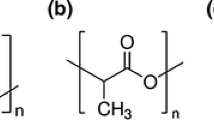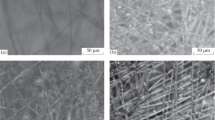Abstract
Structural and morphological changes in the film samples of poly(oxybutyrate-co-oxyvalerate) (P(OB-OV)) and poly-ε-caprolactone (PCL) during accelerated oxidative degradation in the Fenton reagent are studied by IR spectroscopy, DSC, and scanning electron microscopy. It is shown that phase separation of the P(OB-OV) and PCL components is observed in the initial mixture. The melting of different phases of P(OB-OV) is observed at 147 and 157°C, and PCL melts at 61°C. The degrees of crystallinity of P(OB-OV) and PCL in the mixture are 67 and 50%, respectively. It is found that the degradation of P(OB-OV) predominates during the incubation of the samples of the composite in the Fenton solution for 2 to 12 weeks. It is possible to substantially change the rate of oxidative degradation and the molecular weight and degree of crystallinity of a P(OB-OV):PCL polymer composite material by varying the ratio of the components.









Similar content being viewed by others
REFERENCES
Shick, T.M., Abdul Kadir, A.Z., Ngadiman, N.H.A., and Ma’aram, A., A review of biomaterials scaffold fabrication in additive manufacturing for tissue engineering, J. Bioact. Compat. Polym., 2019, vol. 34, no. 6, pp. 415–435.
Sevast’yanov, V.I. and Kirpichnikov, M.P., Biosovmestimye materialy (Biocompatible Materials), Moscow: Nauka, 2011.
Pina, S., Ribeiro, V.P., Marques, C.F., Maia, F.R., Silva, T.H., Reis, R.L., and Oliveira, J.M., Scaffolding strategies for tissue engineering and regenerative medicine applications, Materials, 2019, vol. 12, pp. 1824–1832.
Jafari, M., Paknejad, Z., Rezai, R.M., Motamedian, S.R., Eghbal, M.J., Nadjmi, N., and Khojasteh, A., Polymeric scaffolds in tissue engineering: A literature review, J. Biomed. Mater. Res., Part B, 2017, vol. 105, pp. 431–459.
Shtilman, N.I., Biodegradation of polymers, Zh. Sib. Fed. Univ., Ser. Biol., 2015, vol. 8, no. 2, pp. 113–130.
Volova, T.G., Sevast’yanov, V.I., and Shishatskaya, E.I., Polioksialkanoaty—biorazrushaemye polimery dlya meditsiny (Polyhydroxyalkanoates—Biodegradable Polymers for Medicine), Krasnoyarsk: Platina, 2006.
Abedalwafa, M., Wang, F., Wang, L., and Li, C., Biodegradable poly-epsilon-caprolactone (PCL) for tissue engineering applications: A review, Rev. Adv. Mater. Sci., 2013, vol. 34, pp. 123–140.
Buchanan, F., Degradation Rate of Bioresorbable Materials: Prediction and Evaluation, Cambridge: Woodhead, 2008, part 2.
Thottappillil, N. and Nair, P.D., Scaffolds in vascular regeneration: Current status, Vasc. Health Risk Manage., 2015, vol. 11, pp. 79–91.
Siddiqui, N., Asawa, S., Birru, B., Baadhe, R., and Rao, S., PCL-based composite scaffold matrices for tissue engineering applications, Mol. Biotechnol., 2018, vol. 60, no. 7, pp. 506–532.
Blümm, E. and Owen, A., Miscibility, crystallization and melting of poly(3-hydroxybutyrate)/poly(l–lactide) blends, J. Polym., 1995, vol. 36, pp. 4077–4081.
Furukawa, T., Sato, H., Murakami, R., Zhang, J., Duan, Y.-X., Noda, I., Ochiai, S., and Ozaki, Y., Structure, dispersibility, and crystallinity of poly(hydroxybutyrate)/poly(L-lactic acid) blends studied by FT-IR microspectroscopy and differential scanning calorimetry, Macromolecules, 2005, vol. 38, pp. 6445–6454.
Zhang, L., Xiong, C., and Deng, X., Miscibility, crystallization and morphology of poly(β-hydroxybutyrate)/poly(d,l-lactide) blends, Polymer, 1996, vol. 37, pp. 235–241.
Gassner, F. and Owen, A.J., Physical properties of poly(β-hydroxybutyrate)-poly(varepsilon-caprolactone) blends, Polymer, 1994, vol. 35, pp. 2233–2236.
Avella, M. and Martuscelli, E., Poly-d-(–)(3-hydroxybutyrate)/poly(ethylene oxide) blends: Phase diagram, thermal and crystallization behavior, Polymer, 1988, vol. 29, pp. 1731–1737.
Lotti, N., Pizzoli, M., Ceccorulli, G., and Scando-la, M., Binary blends of microbial poly(3-hydroxybutyrate) with polymethacrylates, Polymer, 1993, vol. 34, pp. 4935–4040.
Kaito, A., Unique orientation textures formed in miscible blends of poly(vinylidene fluoride) and poly[(R)-3-hydroxybutyrate], Polymer, 2006, vol. 47, pp. 3548–3556.
Scandola, M., Ceccorulli, G., and Pizzoli, M., Miscibility of bacterial poly(3-hydroxybutyrate) with cellulose esters, Macromolecules, 1992, vol. 25, pp. 6441–6446.
Godbole, S., Gote, S., Latkar, M., and Chakrabar-ti, T., Preparation and characterization of biodegradable poly-3-hydroxybutyrate-starch blend films, Bioresour. Technol., 2003, vol. 86, pp. 33–37.
Sato, H., Mori, K., Murakami, R., Ando, Y., Takahashi, I., Zhang, J., Terauchi, H., Hirose, F., Senda, K., Tashiro, K., Noda, I., and Ozaki, Y., Crystal and lamella structure and C–H center dot center dot center dot O=C hydrogen bonding of poly(3-hydroxyalkanoate) studied by X-ray diffraction and infrared spectroscopy, Macromolecules, 2006, vol. 39, pp. 1525–1531.
Eastmond, G.C., Biomedical applications of polymer blends, Adv. Polym. Sci., 1999, vol. 149, pp. 59–223.
GOST (State Standard) R ISO 10993-13-2016: Medical Devices. Biological Evaluation of Medical Devices. Part 13. Identification and Quantification of Degradation Products from Polymeric Medical Devices, 2017.
Barham, P.J., Keller, A., Otun, E.L., and Holmes, P.A., Crystallization and morphology of a bacterial thermoplastic: Poly-3-hydroxybutyrate, J. Mater. Sci., 1984, vol. 19, no. 9, pp. 2781–2794.
Funding
This work was partially supported by the Ministry of Science and Higher Education within the execution of the works in line with the State Task to the Branch of the Semenov Federal Research Center of Chemical Physics, Russian Academy of Sciences, state registration number AAAA-A18-118112290069-6, in the part of measuring the degree of crystallinity and thermophysical characteristics of the polymer.
Author information
Authors and Affiliations
Corresponding authors
Ethics declarations
The authors declare that they have no conflicts of interest.
Additional information
Translated by E. Boltukhina
Rights and permissions
About this article
Cite this article
Vasilets, V.N., Pankina, A.P., Nemets, E.A. et al. Study of Structural and Morphological Changes during Accelerated Oxidative Degradation of Mixtures of Polyoxybutyrate with Polycaprolactone. Inorg. Mater. Appl. Res. 13, 872–878 (2022). https://doi.org/10.1134/S2075113322030364
Received:
Revised:
Accepted:
Published:
Issue Date:
DOI: https://doi.org/10.1134/S2075113322030364




